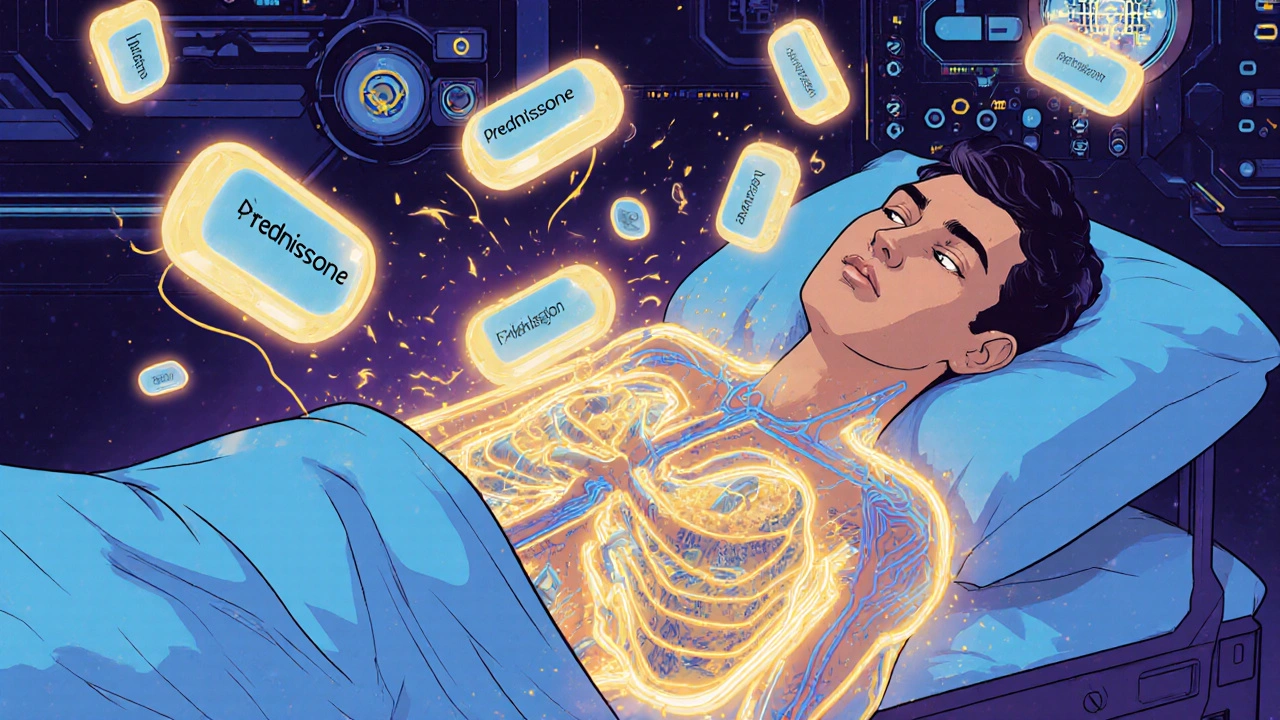Corticosteroid Taper: How to Minimize Withdrawal Symptoms Safely
 Nov, 17 2025
Nov, 17 2025
Corticosteroid Taper Calculator
Personalized Taper Plan Calculator
Calculate your safe taper schedule based on your current steroid dose and treatment duration. This tool follows guidelines from the Mayo Clinic and Endocrine Society.
Stopping corticosteroids like prednisone suddenly can hit you like a truck. Fatigue so deep you can’t get out of bed. Aches in your muscles and joints that feel like the flu never left. Mood swings, nausea, even dizziness when you stand up. These aren’t just side effects-they’re signs your body is struggling to wake up its own cortisol production after being shut down by medication. This is corticosteroid withdrawal, and it’s far more common than most people realize. The good news? You don’t have to ride it out alone. With the right taper plan and support, you can avoid most of these symptoms and get back to feeling like yourself.
Why Tapering Isn’t Optional
When you take corticosteroids for more than two to four weeks, your body stops making its own cortisol. That’s because your brain’s hypothalamic-pituitary-adrenal (HPA) axis-your natural stress-response system-goes quiet. It thinks, "Why make cortisol when the pills are doing it?" That’s fine while you’re on treatment. But when you stop too fast, your body has no backup. The result? Withdrawal syndrome. According to the Mayo Clinic, 78% of patients who quit corticosteroids abruptly experience symptoms like extreme tiredness, weakness, joint pain, and nausea. These aren’t in your head. They’re biological. Your adrenal glands are literally asleep. And waking them up takes time. Tapering isn’t about being cautious-it’s about survival. Skipping the taper can lead to adrenal insufficiency, a medical emergency that can cause low blood pressure, confusion, and even shock. Even if you feel fine, your body isn’t ready. The goal isn’t just to stop the drug-it’s to help your HPA axis come back online safely.How Fast Should You Taper?
There’s no one-size-fits-all schedule. Your taper depends on how long you’ve been on steroids, your dose, and what condition you’re treating. If you were on a high dose-say, more than 20 mg of prednisone daily-you can usually drop by 5 mg every 3 to 7 days until you hit 15 mg. Once you’re below that, slow down. Drop by 1 mg every 1 to 2 weeks. When you get to 5-7.5 mg, go even slower. Some people need weeks or months just to get off that last few milligrams. Why the slowdown? Withdrawal symptoms often start when doses fall below 15 mg. That’s when your body realizes it’s on its own. Studies show 63% of patients report symptoms at this point. Going too fast here is like trying to restart a car with a dead battery-you’ll just stall. For people on long-term therapy (over a year), tapers can stretch six to twelve months. That sounds overwhelming, but it’s the only way to avoid long-term damage. Rushing this phase doesn’t save time-it just adds more suffering later.What Do Withdrawal Symptoms Actually Feel Like?
Withdrawal isn’t just "feeling tired." It’s a mix of physical and mental symptoms that can mimic other problems. Here’s what patients commonly report:- Crushing fatigue-even after full nights of sleep
- Muscle and joint pain that moves around your body
- Nausea, loss of appetite, or dizziness
- Sleep problems: insomnia or sleeping too much
- Anxiety, irritability, or low mood
- Low blood pressure, especially when standing up

How to Manage Symptoms Without Going Back on Steroids
You don’t have to power through this alone. Evidence shows specific strategies can cut symptoms by half or more. Move gently. Walking 20 minutes a day or doing water exercises reduces muscle and joint pain by 42%, according to a 2022 Rheumatology Network study. Physical therapy helped patients drop their pain scores from 7.2 to 3.1 on a 10-point scale in just four weeks. Watch your sleep and caffeine. Getting 7-9 hours of sleep nightly and limiting caffeine to under 200 mg a day (about one strong coffee) lowered symptom severity by 55% in a Mayo Clinic study of over 1,200 patients. Feed your body well. A Mediterranean-style diet-rich in vegetables, fish, nuts, and olive oil-helps stabilize energy and mood. Avoid sugar spikes. They make fatigue worse. Get mental health support. Anxiety and depression during tapering aren’t weakness-they’re neurochemical shifts. Cognitive behavioral therapy (CBT) reduced psychological symptoms by 68% in a trial by the American Addiction Centers. Talking to a therapist isn’t optional-it’s part of the treatment plan. Carry your emergency card. If you’re ever sick, injured, or stressed, your body needs extra cortisol. Always carry a steroid emergency card that lists your max physiological dose (equivalent to 20-30 mg hydrocortisone). This could save your life in an emergency.When to Call Your Doctor
Some symptoms mean you need help right away:- Feeling faint or dizzy when standing (sign of low blood pressure)
- Severe nausea or vomiting that won’t stop
- Confusion or trouble staying awake
- Low blood sugar-shakiness, sweating, rapid heartbeat

Why Some People Struggle Even With a Plan
You’d think following a doctor’s taper plan would be enough. But real life isn’t that simple. A survey of over 12,500 people on Reddit’s r/Prednisone community found 68% still had unexpected withdrawal symptoms-even with a prescribed taper. Over 40% said their fatigue lasted 3 to 8 weeks. One in five had symptoms longer than two months. Why? Three big reasons:- Doctors don’t always explain the plan clearly. 76% of negative reviews mention poor communication.
- Tapers vary wildly between specialists. A rheumatologist might go slow; a gastroenterologist might rush. No consistency.
- Most patients aren’t told what to expect. They think "I’m done with steroids, I should feel better." Instead, they feel worse-and blame themselves.
What’s New in Tapering Science
The field is changing fast. In 2024, the Endocrine Society updated its guidelines to include dynamic tapering-adjusting speed based on your body’s response, not just time. Mayo Clinic rolled out a digital tapering assistant in March 2024. It tracks symptoms, adjusts schedules automatically, and sends alerts. In a pilot of 412 patients, it cut complications by 37%. Researchers are now testing biomarkers like the cortisol awakening response (CAR)-how much cortisol your body releases in the first 30 minutes after waking. This test can predict how fast your HPA axis is recovering, with 82% accuracy. Imagine a taper plan that adapts to you, not the other way around. Long-term, AI-driven systems integrated into electronic health records could become standard. Trials are already underway at Johns Hopkins. The goal? Cut emergency visits related to withdrawal by 215,000 per year by 2027.Your Action Plan
Here’s what to do now:- Ask your doctor: "What’s my taper schedule, and why?" Get it in writing.
- Set up weekly check-ins during the rapid phase, biweekly after you hit 15 mg.
- Start walking 20 minutes a day. Add a Mediterranean diet if you haven’t already.
- Limit caffeine. Prioritize sleep.
- Get a steroid emergency card. Keep it in your wallet or phone.
- Find a therapist or counselor who understands chronic illness and medication withdrawal.
- Track your symptoms in a journal. Note energy, pain, mood, and sleep. This helps your doctor adjust your plan.
How long does corticosteroid withdrawal last?
For most people, symptoms last between 2 to 6 weeks, but some experience them for 2 to 3 months. The length depends on how long you were on steroids and how fast you tapered. People on treatment for less than 3 weeks often recover in 1-2 weeks. Those on long-term therapy (over a year) may take 6-12 months to fully recover their natural cortisol production.
Can I stop prednisone cold turkey after a short course?
If you were on prednisone for less than two weeks and at a low dose (under 7.5 mg daily), you may not need a taper. But if you were on it for more than two weeks-even at low doses-your HPA axis may be suppressed. Stopping suddenly can cause withdrawal symptoms. Always check with your doctor before stopping.
How do I know if it’s withdrawal or a disease flare?
Withdrawal symptoms are generalized: fatigue, muscle aches, nausea, mood changes. A disease flare is specific to your condition. For example, if you have rheumatoid arthritis, a flare means swollen, hot joints. Lupus flares might include a butterfly rash or kidney issues. Blood tests (like CRP or ESR) can help tell the difference. If you’re unsure, get tested before increasing your steroid dose.
Do I need a cortisol test during tapering?
Not everyone does, but if you’re having symptoms at doses below 5 mg, your doctor may order an ACTH stimulation test. This measures how well your adrenals respond to stress. A peak cortisol level above 400-500 nmol/L after the test means your HPA axis is recovering. Below that, you may need a slower taper or temporary support.
What should I do if I feel worse during my taper?
Don’t panic. Don’t stop or restart on your own. Call your doctor. You may need to slow the taper, add temporary support like physical therapy or counseling, or check for adrenal insufficiency. In some cases, a small, short-term dose increase (like 2-5 mg) can help you get through the worst without derailing your plan. Many patients successfully continue tapering after a brief pause.
Are there any supplements that help with steroid withdrawal?
There’s no strong evidence that supplements like licorice root or ashwagandha reliably help with HPA axis recovery. Some may even interfere with your medication. Focus on proven strategies: sleep, nutrition, movement, and mental health support. If you’re considering supplements, talk to your doctor first.
Emily Entwistle
November 19, 2025 AT 15:14OMG YES. I tapered off prednisone last year and thought I was going crazy-fatigue so deep I cried just getting out of bed. Then I found out it wasn’t ‘laziness,’ it was my adrenals napping. 🥲 This post nailed it. Sleep + walking + no caffeine was my lifeline. Also, carry that emergency card. I didn’t, and when I got the flu? SCARY. 🚨
Samkelo Bodwana
November 21, 2025 AT 06:02Look, I’ve been on and off steroids for 11 years due to lupus, and I’ve seen doctors who treat tapering like it’s a grocery list-‘take it down by 5mg every week, done.’ No. It’s not. My HPA axis took 14 months to wake up properly. I had to go from 10mg to 7.5mg over 10 weeks. People think ‘you’re just being dramatic’ when you’re shaking at 3pm because your cortisol’s in hibernation. It’s not a mindset thing. It’s biology. And if your doc doesn’t get that, find someone who does. I switched specialists and my life changed. Also, the Mediterranean diet? Non-negotiable. No sugar spikes. No crashes. Just steady energy. And yes, I cried during week 12 of my 3-month taper. It’s okay to cry. You’re not weak-you’re rebuilding.
Duncan Prowel
November 22, 2025 AT 10:05While the clinical information presented is largely accurate and well-sourced, I must note that the assertion regarding the 78% prevalence of withdrawal symptoms, while cited to the Mayo Clinic, lacks direct reference to a peer-reviewed publication. Additionally, the claim that ‘63% of patients report symptoms below 15mg’ requires clarification: is this based on prospective cohort data or retrospective self-report? The Endocrine Society’s 2024 guidelines do indeed endorse dynamic tapering, but their position statement emphasizes individualized assessment over algorithmic reduction. Furthermore, the efficacy of CBT in reducing psychological symptoms by 68%-while compelling-was derived from a small, non-blinded trial with potential selection bias. A more rigorous meta-analysis would be preferable before universal adoption of these figures as standard.
Sameer Tawde
November 23, 2025 AT 12:51Walk every day. Sleep like your life depends on it. Eat real food. That’s it. No magic pills. Just patience. You got this.
Jonathan Gabriel
November 24, 2025 AT 13:30So let me get this straight-after years of being told ‘just take the pill,’ now we’re supposed to treat withdrawal like it’s a spiritual awakening? ‘Be kind to yourself’? Cool. Meanwhile, my insurance won’t cover my therapist, my PT, or my ‘emergency card’ because ‘it’s not a real condition.’ Oh, and the ‘digital tapering assistant’? Yeah, that’s probably coded by a guy who’s never had to wake up at 3am because his body thinks it’s dying. Funny how Big Pharma’s happy to keep you on steroids for life… but once you try to quit? Suddenly it’s ‘your responsibility to track your mood in a journal.’ 😏
Sarbjit Singh
November 26, 2025 AT 12:41Bro, I was on 40mg for 8 months for my asthma. Tapered over 7 months. Felt like I was melting inside. But I did the walk, the sleep, the fish and veggies. And guess what? I’m off now, no relapse, no crash. You’re not broken. You’re just relearning how to be you. And yeah, your doctor might not get it. But you do. Keep going. I’m proud of you. 💪❤️
Angela J
November 26, 2025 AT 19:00Wait… so you’re telling me the government and big pharma didn’t tell you this because they WANT you to stay on steroids forever? That’s why they don’t train doctors on HPA axis recovery-it’s not profitable. And the ‘digital assistant’? That’s just a tracker for your data so they can sell it. And the ‘emergency card’? That’s a trap. What if you’re in a car crash and they see ‘steroid user’ and give you the wrong meds? I’ve seen it happen. They’re gaslighting you into thinking you’re ‘safe’ when you’re just another statistic in their database. 🕵️♀️💊
Jeff Hakojarvi
November 27, 2025 AT 13:50Just wanted to add-when I hit 5mg, I started having panic attacks at night. Thought I was losing my mind. Ended up talking to a therapist who specialized in chronic illness withdrawal. She told me it wasn’t anxiety-it was cortisol crashing. We adjusted my taper to 2.5mg every 10 days instead of weekly. Made all the difference. Also, magnesium glycinate helped with the muscle cramps. Not a cure, but it helped me sleep. Don’t feel guilty for needing help. You’re not failing. You’re healing.
Timothy Uchechukwu
November 28, 2025 AT 15:16Why do we even need to taper? Why not just let people’s bodies handle it? This is why America is weak. Back home in Nigeria, we just stop. No journal. No card. No therapist. Just pray and keep walking. You think your body can’t handle it? Then maybe you were never strong enough to begin with. This whole post feels like coddling. People need discipline not spreadsheets.
Bruce Bain
November 29, 2025 AT 13:27I’m from the Midwest and I’ve been through this. All I know is: if you’re tired, rest. If you hurt, move slow. If you’re sad, talk to someone. Don’t overthink it. Your body knows what to do. You just gotta give it time. And yeah, that emergency card? Worth its weight in gold. I keep mine next to my wallet. Simple. Smart. Done.